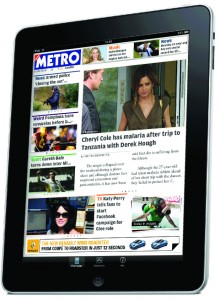For those of you that have been in hiding and didn’t know, Apple’s iPad launched in the UK today with granular reports from the media on who was the first to buy the device to who was the first to emerge from Apple’s London store holding one (hopefully we’ll soon have details of who’s been the first person to leave theirs on the London Underground or to ask for a refund).
Bit of a love-in for the Apple store in the Telegraph’s report:
While braving the cold, the trio were given food and drinks by sympathetic Apple staff with several other customers offering them hundreds of pounds to replace them in line.
As Jake ran into the store, after a countdown, he was greeted by screams and cheers from dozens of excited staff members who hugged and high-fived him before posing for the world’s media.
And plenty of coverage from the Guardian, which, despite having its website on much of Apple’s pre-launch marketing material, has decided not to launch a news app on the device in time for launch. The title did announce today, however, that its Eyewitness photography app has been downloaded more than 90,000 times since the US launch of the product in April.
The Financial Times, as expected, and the Times have jumped onto the new touchscreen bandwagon. The Times iPad edition comes hot on the heels of the launch of its new website earlier this week, though the app’s pricing structure adds another layer to News International’s paywall plans.
Accompanying the Times’ launch, an article on ‘How iPad may make the future of newspapers a different story’, which suggests that:
Many media organisations think that it will give them the opportunity to correct past mistakes with online journalism, allowing them to charge customers for content and in return provide an enriched experience more compelling and interactive than printed newspapers.
Let’s hope the latter does come hand-in-hand with the former to make these news apps something worth paying for. New research from analysts Ovum warns publishers about sticking all their eggs in one Apple-shaped basket and ignoring other devices and a digital strategy addressing all platforms: web, mobile, tablet and future. At least the Financial Times, which is operating a standard, tiered pricing structuring across its various digital outlets, seems to get this. Meanwhile, media journalist Patrick Smith wonders whether you need a news app at all, arguing that apps are a convenient, but limited way of publishing information.
As a Financial Times report earlier this week says:
[M]any of the most popular European publications on the web – including the Guardian, the Daily Mail and the Economist – will not be in the App Store when the iPad launches in nine countries this Friday.
Digital publishers, analysts and design experts say the first publishers’ apps are confusing to use or boringly faithful to the offline product, and are not being used as much as hoped.
Media organisations might get the charging for content right this time around (although the Times’ model leaves some questions), but will content and designing to make the most of the iPad’s features be overlooked by some news organisations in the rush?
